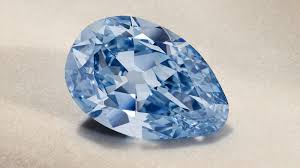Golconda—today the region around Hyderabad—has long been synonymous with some of the world’s most celebrated diamonds. In recent years collectors and the press have focused not only on long-known Golconda greats but also on a string of high-profile blue and pink stones whose auctions, withdrawals and contested provenances renewed interest in the region’s gem-rich past.
THE GOLCONDA BLUE DIAMOND
The most conspicuous recent story was “The Golconda Blue,” a spectacular 23.24-carat Fancy Vivid Blue that Christie’s presented as the headline lot for its Geneva Magnificent Jewels sale in May 2025. Christie’s billed the stone as the largest Fancy Vivid Blue ever offered at auction and placed a very high estimate on it; the announcement revived conversation about Golconda-origin blues and royal Indian provenance. Shortly after the press release, however, the seller withdrew the lot and the sale did not proceed — a development widely reported and one that underlined how provenance, legal clearances and owner decisions can suddenly change the public life of a historic precious stone. Some experts continue to disbelieve the reason given by Christie’s, to cancel the auction of the Golconda diamond.
THE SERAPHIM BLUE DIAMOND
Running alongside such modern auction drama are older, more mysterious names. The Seraphim Blue Diamond is a legendary fancy-blue often linked in popular accounts to the Nizams of Hyderabad and to turban ornaments seen in early portraits. The provenance of this Golconda diamond is believed to originate around 1724. That was when Asaf Jah I the first Nizam of Hyderabad, took control of the Deccan region including the area that housed the famed Golconda diamond mines.
Reports narrate how the modestly sized, pear shaped Seraphim Blue Diamond, was given (not sold, not forcefully taken) to the French by Asaf Jah II. This was to wholly or partially settle payment, for receiving military support from the French. It is believed that the Nizams, later made similar arrangements with the British.
THE PRINCIE (PINK) DIAMOND
Not all recent attention has centered on blues. The Princie Diamond, a 34.65-carat intense pink of Golconda origin, remains one of the most headline-grabbing Golconda stones of the past decade. Sold at Christie’s New York in April 2013 for about $39.3 million, the Princie set records for Golconda-mine pinks and later generated legal controversy when ownership claims surfaced — a reminder that spectacular sales often bring fresh scrutiny to provenance and title.
MORE GOLCONDA DIAMONDS
These contemporary episodes sit on top of a long, influential history: Golconda’s alluvial mines produced the Koh-i-Noor, the Hope, the Darya-i-Nūr and others that traveled through royal treasuries, colonial markets and museum displays. That deep history fuels both scholarly study and the more speculative stories that surface whenever a rare colored stone appears on the market. The combination of extraordinary color, royal associations (especially with the Nizams) and gaps in archival paper trails makes attribution and provenance central — and often contentious — aspects of every modern Golconda diamond story.
For serious collectors the takeaway is practical: treat sensational press reports as starting points, not conclusions, and expect due diligence — lab reports, documented ownership chains, and expert provenance research — to be decisive when value, history and legality intersect.

